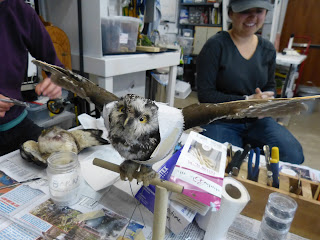Taxidermy Party
We celebrate birthdays a bit differently around the Museum. Cake and singing are still involved--and I'm particularly thankful that our Director has an affinity for the giant pieces of chocolate cake made across the street. As one of our summer interns just celebrated her birthday, Collections staff found it an appropriate time to commence our annual taxidermy session. After all, what better way is there to recognize someone's big day than to help her discover the joys of looking inside a bird?
As with most birthday celebrations, many photos were taken that day. I can certainly attempt to describe the complicated beauty of taxidermy, but this time I feel as if photos would do the experience more justice than my words. The following is a montage of various steps involved in the process. Note the delicate balance of smiles, laughter, and concentration.
Before beginning our work, the girls made sure to pose with our respective birds. I had some limited taxidermy experience previously and was persuaded to test my skills on a barred owl. Our interns Sarah (left) and Kristina (right) were eager to try taxidermy with two red crossbills.
I had pulled the birds from our salvage freezer the night prior, allowing them to thaw for the next morning. Each remained accompanied by necessary records which guided our understanding of what may have happened in each bird's last moments.
We began with laying out the birds to inspect them. John prefaced our work with insight about the practice of taxidermy and then proceeded to walk us through each step as he effortlessly demonstrated on a boreal owl.

Taxidermy is messy work, and all were delightfully disgusted by the opportunity to explore the inner anatomy. I was personally amazed by the length of the barred owl's esophagus and lack of muscle around its exposed keel. During the first day, we worked to separate inner muscle tissue from skin and feathers.
Naturalist Haley Appleman was able to join in the second day with a broad-winged hawk and discovered the remains of a frog still preserved in its crop. What an interesting surprise!
All five birds are well on their way to becoming finished taxidermy mounts. Over the next few days, we will continue to check in on the drying mounts as toweling and pins help us to work feathers into their final position. I was grateful to share the experience with a fun group of staff and suspect they enjoyed it as well. Happy Museum birthday, Sarah!










